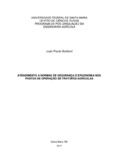| dc.creator | Barbieri, Juan Paulo | |
| dc.date.accessioned | 2017-08-21T15:34:11Z | |
| dc.date.available | 2017-08-21T15:34:11Z | |
| dc.date.issued | 2017-03-02 | |
| dc.identifier.uri | http://repositorio.ufsm.br/handle/1/11397 | |
| dc.description.abstract | In modern agriculture, the agricultural tractor is an essential equipment for the accomplishment of the numerous agricultural operations of a property. Since the first tractors with internal combustion engine, big transformations have occurred in their projects, and the operating station where the most notable changes, as systems are constantly undergoing updates, and the manufacturers thinking about the comfort of the operator and the compliance with national and international regulations. The objective of this work was to evaluate and compare the conformity of the new agricultural tractors commercialized in the Brazilian market, with the specifications standardized by national and international standards of safety and ergonomics, qualifying the operating stations with the created of an ergonomic index. The agricultural tractors were divided into classes according to the gross power in the engine. In the agricultural tractors, the operating controls were measured in relation to the Seat Index Point, the measures of access and exits of the operation station, besides observing the presence of obligatory items in agricultural tractors. The main results show that Class VI agricultural tractors (above 200 CV) showed the highest compliance with ISO 15077, with regard to the internal position of the controls in the operating station. Between the controls, the gear lever was the one that best complied with the ISO 15077. As for the compliance with the ABNT NBR ISO 4254-1, the tractors without cabin had less conformity than the cabin. All the operating stations had at least two emergency exits, as required by ABNT NBR 4252. Most of the mandatory items provided for in NR 12 are present or agreed at the farm tractor stations evaluated. The 4CC operating station presented the best Ergonomic Index among the sampled operating stations and the 2NA Operational Station presented the lowest Ergonomic Index and it was efficient in terms of feasibility and can be applied to other models of agricultural tractors and machines. | eng |
| dc.language | por | por |
| dc.publisher | Universidade Federal de Santa Maria | por |
| dc.rights | Attribution-NonCommercial-NoDerivatives 4.0 International | * |
| dc.rights.uri | http://creativecommons.org/licenses/by-nc-nd/4.0/ | * |
| dc.subject | Conformidade | por |
| dc.subject | Itens | por |
| dc.subject | Comandos | por |
| dc.subject | Acesso | por |
| dc.subject | Índice ergonômico | por |
| dc.subject | Conformity | eng |
| dc.subject | Items | eng |
| dc.subject | Commands | eng |
| dc.subject | Access | eng |
| dc.subject | Ergonomic index | eng |
| dc.title | Atendimento a normas de segurança e ergonomia nos postos de operação de tratores agrícolas | por |
| dc.title.alternative | Attendance of safety and ergonomic standards at the agricultural tractors operation posts | eng |
| dc.type | Dissertação | por |
| dc.description.resumo | Na agricultura moderna, o trator agrícola é equipamento fundamental para a realização das inúmeras tarefas de uma propriedade. Desde os primeiros tratores com motor de combustão interna, ocorreram grandes transformações em seus projetos, sendo que o posto de operação foram as de mudanças mais notórias, pois os sistemas estão constantemente passando por atualizações, e os fabricantes pensando no conforto do operador e no atendimento a normativas nacionais e internacionais. Este trabalho teve como objetivo avaliar e comparar a conformidade dos postos de operação de tratores agrícolas novos comercializados no mercado brasileiro, com as especificações padronizadas por normas nacionais e internacionais de segurança e ergonomia, qualificando os postos de operação com a criação de um índice ergonômico. Os tratores agrícolas foram divididos em classes de acordo com a potência bruta no motor. Nos tratores agrícolas, foram medidos os comandos de operação em relação ao Ponto de Indexação do Assento, as medidas de acesso e saídas do posto de operação, além de observar a presença de itens obrigatórios em tratores agrícolas. Os principais resultados revelam que tratores agrícolas da Classe VI (acima de 200 cv) apresentaram a maior conformidade com a norma ISO 15077, no que se refere à disposição interna dos comandos no posto de operação. Dentre os comandos, a alavanca de marchas foi a que melhor atendeu à norma ISO 15077. Quanto à conformidade com a norma ABNT NBR ISO 4254-1, os tratores sem cabine apresentaram menos conformidades em relação aos com cabine. Todos os postos de operação apresentaram no mínimo duas saídas de emergência, conforme exige a norma 4252. I. A maioria dos itens obrigatórios previstos pela NR 12, estão presentes ou de acordo nos postos de operação dos tratores agrícolas avaliados. O posto de operação 4CC apresentou o melhor Índice Ergonômico dentre os postos de operação amostrados, e o posto de operação 2NA apresentou o menor Índice Ergonômico e este mostrou-se eficiente quanto a exequibilidade e pode ser aplicado em outros modelos de tratores e máquinas agrícolas. | por |
| dc.contributor.advisor1 | Schlosser, José Fernando | |
| dc.contributor.advisor1Lattes | http://lattes.cnpq.br/0575023987760421 | por |
| dc.contributor.referee1 | Romano, Leonardo Nabaes | |
| dc.contributor.referee1Lattes | http://lattes.cnpq.br/1310558353123248 | por |
| dc.contributor.referee2 | Ferreira, Mauro Fernando | |
| dc.contributor.referee2Lattes | http://lattes.cnpq.br/1174365712576863 | por |
| dc.creator.Lattes | http://lattes.cnpq.br/6194371840243163 | por |
| dc.publisher.country | Brasil | por |
| dc.publisher.department | Engenharia Agrícola | por |
| dc.publisher.initials | UFSM | por |
| dc.publisher.program | Programa de Pós-Graduação em Engenharia Agrícola | por |
| dc.subject.cnpq | CNPQ::CIENCIAS AGRARIAS::ENGENHARIA AGRICOLA | por |
| dc.publisher.unidade | Centro de Ciências Rurais | por |



